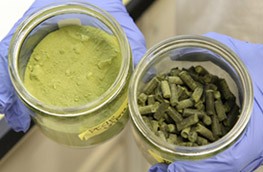Is Algae The Answer For “Greener” Beef?

By Mary Rose Thomas-Glaser
Cattle ranchers know only too well the enormous quantities of feed that cows devour on a daily basis and the expansive acreage they need for grazing. Environmentalists are concerned with the large amount of methane produced by grazing cows through belches and manure as they digest grasses and grains. To reduce feed costs and lower methane emissions, researchers have begun to explore alternative feedstocks that may be able to solve both dilemmas.
The Problem With Ruminating
Cows are ruminants whose ravenous appetite is due in large part to their inefficient digestive system, which requires repeated chewing of food. As a result, cattle require up to 28 times more land and 11 times as much water as chickens or pigs and produce up to five times the amount of carbon emissions. According to Gidon Eschel, Professor of Environmental Science and Physics at Bard College, “The carbon footprint of conventional beef is nearly entirely due to production of its feed.”
Boosting Cattle Feed With Biofuel Waste
The key to reducing cost and carbon for cattle may lie in supplementing the traditional farm grain and grass with an eco-friendly and economical supplement. And researchers may have found a viable option in one of the world’s most ubiquitous plants — algae. Algae are photosynthetic plants that grow in fresh and sea waters around the world and produce most of the Earth’s oxygen. Best of all, algae can be commercially cultivated and requires very little land, water or energy.
Researchers at Solazyme, a California-based biotechnology firm, have been growing algae for use as biofuel using waste sugar cane in fermentation tanks. Algal residue from the oil extraction process had been burned, but Stephanie Hansen and her team wanted a more sustainable use for the waste which contains fat, fiber and protein. Blending the waste into cattle feed added nutrition and didn’t seem to affect palatability. “The algae meal would be best suited as a part of a complete diet for cattle, replacing a portion of the corn or other feedstuffs typically used in the diet,” Hansen concluded.
Based on the study results, researchers are awaiting FDA approval and aim to have the algal meal available for farmers by 2016.
Extension Questions
- How do the stomachs of ruminants differ from nonruminants? How do the differences affect diet and digestion?
- Research algae. Where does it grow, what are the different types and what are its commercial uses?
- How do plants convert sunshine into food? What are the byproducts of the process?
